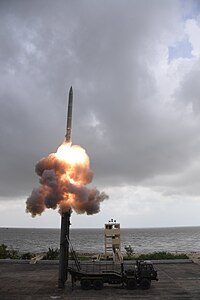SMART (missile)
Topic: Engineering
 From HandWiki - Reading time: 4 min
From HandWiki - Reading time: 4 min
| SMART | |
|---|---|
 SMART launched from Integrated Test Range | |
| Type | Anti-submarine missile |
| Place of origin | India |
| Service history | |
| Used by | Indian Navy |
| Production history | |
| Designer | Defence Research and Development Organisation |
| Designed | 2018–19 |
| Specifications | |
| Warhead | Advanced Light Torpedo Shyena |
| Engine | Missile: Two-stage solid rocket Torpedo: Electric |
| Propellant | Solid fuel + silver zinc battery |
Operational range | 643 km (400 mi) + 20 km (12 mi) |
Guidance system | Mid-course: Inertial navigation system with mid-course update via datalink Terminal: Acoustic homing (active/passive) |
Launch platform |
|
SMART (Supersonic Missile Assisted Release of Torpedo) is a canister-based, long-range anti-submarine missile developed by the Defence Research and Development Organisation (DRDO) for the Indian Navy.[1]
Description
SMART is a canisterised hybrid system, made up of long-range missile carrier that can travel at supersonic speed and a lightweight torpedo as payload for anti-submarine warfare (ASW) role. The objective behind the project is to develop a quick reaction system that can launch torpedo from standoff distance.[2] The missile has a range of 643 km (400 mi) carrying a light weight torpedo of range 20 km (12.5 mi) with 50 kg high explosive warhead.[3] SMART uses two-way data link connected to airborne or ship based submarine detection and identification systems.[2] SMART can be launched from a surface ship or a truck-based coastal battery.[4][5] The missile delivery system was developed jointly by Defence Research Development Laboratory (DRDL) and Research Centre Imarat (RCI). Naval Science and Technological Laboratory (NSTL) developed the autonomous lightweight torpedo and associated technologies such as detonation mechanism, underwater guidance and underwater thruster. Aerial Delivery Research and Development Establishment (ADRDE) developed the velocity reduction mechanism that act before releasing an autonomous lightweight torpedo towards the designated target. SMART is part of fusion project to combine technologies of institutions dealing with land and naval based armaments.[6][7] High Energy Materials Research Laboratory (HEMRL) developed the insensitive explosive formulations for naval warhead.[8] Ministry of Defence (MoD) in 2018–19 annual report mentioned that DRDO started the development and demonstration of missile assisted release of light weight torpedo for ASW role. The ejection trial was done using Advanced Light Torpedo Shyena.[9][10]
The missile is powered by a dual stage solid-propellant rocket and utilizes electro-mechanical actuators for course correction. For in-flight guidance, SMART uses a inertial navigation system (INS), and allows real-time course correction and target updating via datalink. The missile utilizes sea skimming in order to reduce detection range.[5][11] SMART is similar in concept to the now cancelled UUM-125 Sea Lance from Boeing.[9] The system is under-development due to increasing deployment of submarines by People's Liberation Army Navy Submarine Force (PLANSF) in the Indian Ocean Region (IOR), rapid modernization of naval assets by People's Liberation Army Navy (PLAN) and the building of Chinese overseas military bases in Africa.[12][13][14]
Trials
First trial
The first successful test of SMART was done on 5 October 2020 from Abdul Kalam Island. This was part of demonstration test to check missile flight for maximum range and altitude, separation of the nose cone, release of torpedo and deployment of velocity reduction mechanism.[5]
Second trial
On 13 December 2021, the second test of SMART was conducted successfully from Integrated Test Range (ITR), Odisha.[15] The entire trajectory was monitored by the electro-optic telemetry system, various range radars including the downrange instrumentation and downrange ships. The missile carried a torpedo, parachute delivery system and release mechanisms.[16]
See also
- RUM-139 VL-ASROC
- Type 07 Vertical Launch Anti-submarine rocket
- RPK-6 Vodopad/RPK-7 Veter
- Hong Sang Eo
- RPK-2 Vyuga
- UUM-125 Sea Lance
References
- ↑ "India successfully tests long-range Supersonic Missile Assisted Torpedo off Balasore coasts" (in en). 2021-12-13. https://www.hindustantimes.com/india-news/india-successfully-tests-long-range-supersonic-missile-off-balasore-coasts-101639390685661.html.
- ↑ 2.0 2.1 Dutta, Amrita Nayak (2020-10-07). "The SMART torpedo system and why DRDO is calling it 'game changer' in anti-submarine warfare" (in en-US). https://theprint.in/defence/the-smart-torpedo-system-and-why-drdo-is-calling-it-game-changer-in-anti-submarine-warfare/518428/.
- ↑ Lendon, Brad (7 October 2020). "India tests long-range anti-submarine missile". https://www.cnn.com/2020/10/06/asia/indian-anti-submarine-missile-ml-intl-hnk-scli/index.html.
- ↑ "India successfully tests Supersonic Missile assisted release of Torpedo". Zee Media Corporation. 5 October 2020. https://www.wionews.com/india-news/india-successfully-tests-supersonic-missile-assisted-release-of-torpedo-332608.
- ↑ 5.0 5.1 5.2 "India test-fires SMART torpedo to target submarines". 5 October 2020. https://www.rediff.com/news/report/india-test-fires-smart-torpedo-to-target-submarines/20201005.htm.
- ↑ Rout, Hemant Kumar (5 October 2020). "In major breakthrough, India successfully tests supersonic missile-assisted release of torpedo". PTI. The New Indian Express. https://www.newindianexpress.com/nation/2020/oct/05/in-major-breakthrough-india-successfully-tests-supersonic-missile-assisted-release-of-torpedo-2206076.html.
- ↑ "DRDO's SMART missile could be trump card against China's submarines". PTI. The Week. 5 October 2020. https://www.theweek.in/news/india/2020/10/05/explainer-drdo-smart-missile-could-be-trump-card-against-china-submarines.html.
- ↑ "Insensitive explosive compositions for Naval warheads". 16 December 2021. https://www.drdo.gov.in/technology-cluster-links/labs-products-detail/1724/177.
- ↑ 9.0 9.1 "Explainer: DRDO's SMART missile could be trump card against China's submarines" (in en). 5 October 2020. https://www.theweek.in/news/india/2020/10/05/explainer-drdo-smart-missile-could-be-trump-card-against-china-submarines.html.
- ↑ "Annual Report 2018-19". Ministry of Defence, Government of India. https://www.mod.gov.in/sites/default/files/MoDAR2018.pdf.
- ↑ Manjeet Negi (2021-12-13). "DRDO successfully tests long-range 'Supersonic Missile Assisted Release of Torpedo' - Science News". https://www.indiatoday.in/science/story/drdo-long-range-supersonic-missile-assisted-release-of-torpedo-test-navy-defence-1887232-2021-12-13.
- ↑ Unnithan, Sandeep (15 October 2018). "China positions submarine and rescue vehicle in Indian Ocean" (in en). https://www.indiatoday.in/india/story/china-positions-submarine-and-rescue-vehicle-in-the-indian-ocean-1368286-2018-10-15.
- ↑ "China Naval Modernization: Implications for U.S. Navy Capabilities—Background and Issues for Congress". Congressional Research Service. https://sgp.fas.org/crs/row/RL33153.pdf.
- ↑ George, Steve; Lendon, Brad (14 March 2018). "'Weaponizing capital': US worries over China's expanding role in Africa". https://www.cnn.com/2018/03/09/asia/djibouti-port-china-us-intl/index.html.
- ↑ "India successfully test-fires supersonic missile assisted torpedo in Odisha" (in en). 2021-12-13. https://www.livemint.com/news/india/india-successfully-tests-supersonic-missile-assisted-torpedo-in-odisha-11639388969736.html.
- ↑ Kulkarni, Sushant (2021-12-13). "Successful flight test of supersonic missile-assisted torpedo release system conducted" (in en). https://indianexpress.com/article/cities/pune/successful-flight-test-of-supersonic-missile-assisted-torpedo-release-system-conducted-7671007/.
 |
 KSF
KSF